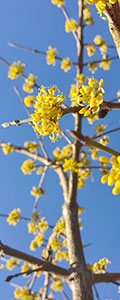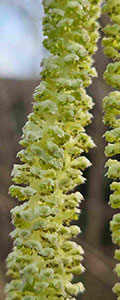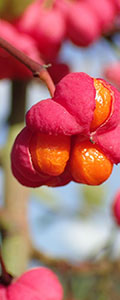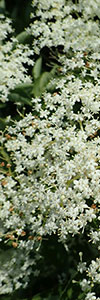

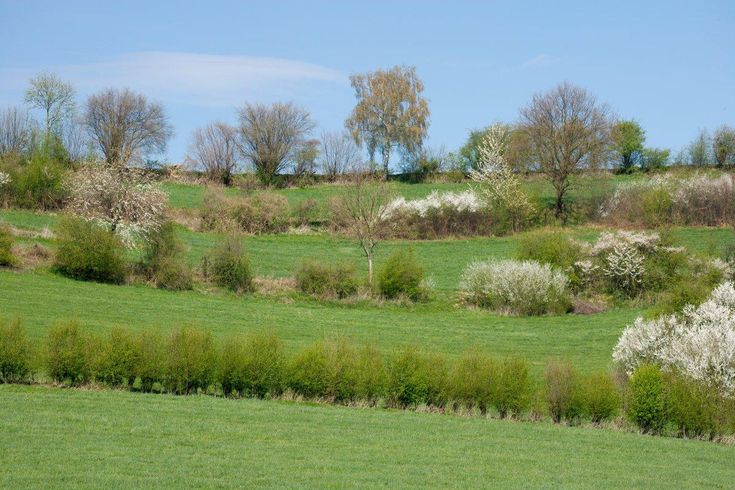

Not a fence but a mixed hedgerow!
18/02/2024
A hedge or hedgerow is the most environmentally friendly fence for your ecological garden. It can be a nice way to create zones in your garden. Moreover, it’s beautiful, green, inexpensive and grows naturally. A hedge mainly consists of a mix of shrubs and bushes planted close together. You can opt for a tightly clipped hedge, which is regularly pruned to keep it in shape. Frequent pruning gives you a densely branched network. Or you can go for a taller, wider and wilder hedgerow that requires hardly any maintenance. No or less pruning has the advantage of giving you more blooms and berries, the ideal food supply for insects, birds and small mammals. Unsurprisingly, the latter category has a higher ecological value for biodiversity.
A hedge/hedgerow performs many functions. We list several benefits here.
A hedge:....
A hedge or hedgerow is therefore a top sanctuary for our biodiversity. It is one of our most important small landscape elements of old-time bocage landscapes. A bocage landscape is a semi-open landscape of meadows, hayfields and fields with lots of hedgerows, walls and thickets. If you prefer as little maintenance as possible and have enough space, go for a hedgerow.
Did you know that before there was barbed wire, people used hawthorn and blackthorn as pasture fencing. The many thorns ensured that the cattle did not eat them or run away. Another great story is that people used willow branches as pasture poles that then took root and this then eventually evolved to beautiful pollarded willow rows that also provided a lot of wood.
If you don't have enough space in your garden for a hedge, you can work with climbing plants to green your fences. But that is for another blog, so be sure to keep following us here.
Also keen to plant a hedge or hedgerow. Feel free to contact us and we will help you make the right choice of species you like and that do well on your soil and tell you exactly how to get started.
A hedge/hedgerow performs many functions. We list several benefits here.
A hedge:....
- is a way of fencing your garden en give you more privacy
- gives structure to your garden or landscape, creates shade and reduces erosion
- creates a microclimate because it blocks the wind and retains water longer in the soil
- provides a floral display and is a feast for the eyes
- is a great addition to your garden, but also in a meadow and/or orchard
- shelters and accommodates many animal species
- is a nectar buffet for insects during flowering, which in turn attracts insectivorous birds
- offers many berries to birds, rodents and hedgehogs, but possibly also to humans
- is like a thicket with lots of nesting opportunities for birds
- helps combat pests thanks to its high biodiversity
- functions as a true corridor and thus contributes to the connection of the ecological network
A hedge or hedgerow is therefore a top sanctuary for our biodiversity. It is one of our most important small landscape elements of old-time bocage landscapes. A bocage landscape is a semi-open landscape of meadows, hayfields and fields with lots of hedgerows, walls and thickets. If you prefer as little maintenance as possible and have enough space, go for a hedgerow.
Did you know that before there was barbed wire, people used hawthorn and blackthorn as pasture fencing. The many thorns ensured that the cattle did not eat them or run away. Another great story is that people used willow branches as pasture poles that then took root and this then eventually evolved to beautiful pollarded willow rows that also provided a lot of wood.
There are plenty of native species to choose from for your hedge.
Some of our favourite natives:
- Yellow dogwood is a beautiful shrub that is already in bloom this month (February). Red dogwood is especially beautiful for its red stems in autumn and winter. Birds love the dark blue berries.
- The wild privet stays nicely green in winter and we find many bird nests within
- Blackthorn and hawthorn have beautiful blossoms in spring and lots of berries in summer and their thorns keep predators away from birds
- The yellow catkins (the male flowers) of the hazel are also blooming now and will give you tasty hazelnuts after a few years
- Raspberries also do well in a mixed hedge and are also delicious for us
- The woody elder produces beautiful white flower umbels that are crowded by insects and the berries in turn by birds
- Grey willow or goat willow is a highly sought after species by many insects and one of the early bloomers. They prefer moist soil.
- Alder buckthorn is less well known but a nectar-top plant with strongly sought-after black berries for the birds
- The red-purple fruit of spindle trees makes this native species highly ornamental
- If you like roses, go for dog rose or eglantine, our native single-petaled roses, which are also very decorative. The cultivated roses are double or multiple-petaled which means insects cannot get to the nectar. They therefore have no added value for biodiversity and require much more maintenance.
If you don't have enough space in your garden for a hedge, you can work with climbing plants to green your fences. But that is for another blog, so be sure to keep following us here.
Also keen to plant a hedge or hedgerow. Feel free to contact us and we will help you make the right choice of species you like and that do well on your soil and tell you exactly how to get started.
Comments
No comments have been added yet. Be the first to add a comment. Add a comment



